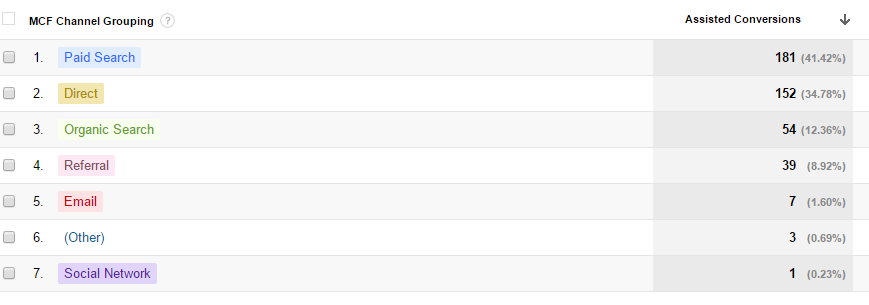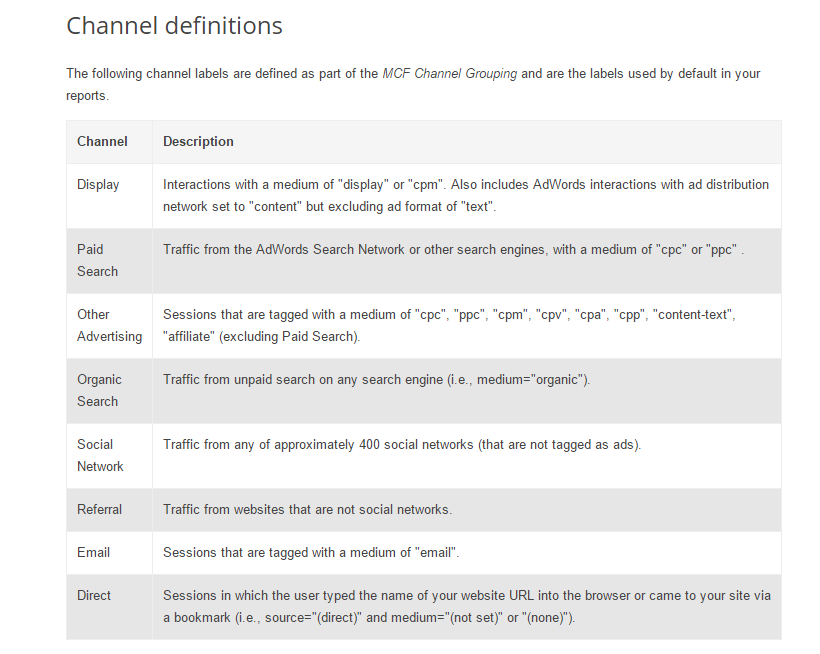 Assisted conversions in Google Analytics is the least understood and possibly one of the most import metrics to understand. Every single client that we have gets introduced to assisted conversions and it is part of our discussion in our weekly meetings. Assisted conversions, specifically the top conversion paths, shows us the “story” behind the business’s marketing campaign.
Assisted conversions in Google Analytics is the least understood and possibly one of the most import metrics to understand. Every single client that we have gets introduced to assisted conversions and it is part of our discussion in our weekly meetings. Assisted conversions, specifically the top conversion paths, shows us the “story” behind the business’s marketing campaign.
What is Assisted Conversions?
Assisted Conversions can be found in Google Analytics under Multi-Channel Funnels. To be able to view any data in this area, conversion tracking must be enabled and a goal must be created and/or e-commerce tracking must be enabled.
Google has grouped sources into predefined channels. You can see the channels that Google has used below.
This is a screen shot from a client’s account. AdWords automatically is assigned to the Paid Search channel since it is a Google property and you can set up AdWords to automatically tag the URLs from the ads so that they can be tracked in Analytics. For other sources such as Bing Ads, it’s important to properly add tracking parameters to the URLs so that you can track it in Analytics. By adding “cpc” to the medium in your tracking parameters, Google will assign that source to the Paid Search channel.
Within this view you can analyze the data using Assisting Interaction Analysis, First Interaction Analysis and Conversions. Analyzing this data will not be addressed in this article, however you can read more on it on Google’s support page Analyze channel contribution.
Top Conversion Paths
The focus of this article is in the “story” that is being told in Analytics in regards to your marketing campaign. Marketing online has grown significantly in recent years. It has gone from banner advertisement and SEO in the early days of the web toPay Per Click with many different platforms to advertise on, like Bing, AdWords, Amazon, Facebook, etc.. Social media marketing, SEO and so on. Presence on the web is key. As you continue to develop your marketing campaign, you should consider all of the different sources available to advertise on. A well developed marketing campaign will take advantage of the different sources and develop a plan for each.
To see the data in Top Conversion Paths you would click on Multi-Channel Funnels > Top Conversion Paths.
Screenshot for Top Conversion Paths below
In Top Conversion Paths you will be able to see conversions that took place after the first visit, to conversions that takes multiple visits. If you look at number 18., notice that it took 50 visits before three conversions happened. These are all e-commerce transactions.
When analyzing this data it really helps you to understand people’s buying habits and the type of research they go through before making a purchase.
As the marketing campaign expanded for this client, the paths have gotten longer. What does this mean? People visit different sources before making the final decision on what and where to buy. The fact that the paths have gotten longer means that we are present on many more sites and are able to bring the prospective client back to the site.
Imagine for a moment that you are only working on getting organic rankings through SEO. This limits your sources to Google, Bing/Yahoo and other search engines. If you sell tangible products, that are being sold on other retail sites like Amazon, what are the chances for those clients to get back to your site and purchase? People use Amazon for product research and reviews. If you have no presence on Amazon through Amazon Product Ads, then someone may find the product on Amazon and buy it there from another retailer or Amazon itself. Presence on the web is key. This is why a well developed marketing campaign will consider expanding into select sources from each channel. The greater the online presence, the greater the chance of someone coming back to your site.
The Story
Below you will see the predefined channels that Google assigns sources to.
When you compare your conversion paths to the predefined channels, you can see the “holes” in your marketing campaign. If most of your paths consist of Organic and Direct, maybe it’s time to look into Paid Search. If most of your paths consist of Paid, Organic and Direct, maybe you should consider developing a plan for social media marketing. Do you see where I am going with this? The lack of channels in the paths are indicators of what’s missing in your campaigns. If you have no presence on Facebook with either a paid campaign or social campaign or both, what are the chances that you will get sales from Facebook? The chances are very slim since it would take someone to share your product or site to their friends. You’re kinda leaving it up to chance by doing this. Being proactive and taking the necessary steps to develop your marketing campaign will help to ensure that your business can be successful.
Steps To Take In Reading Your Story
- Analyze the paths.
- Compare the channels that you have with that of Google’s predefined channels.
- Once you see which channels are missing, look into the sources that Google automatically assigns to each channel.
- Consider which sources that you would like to use in your expanded marketing plan. For example: for social, do you want to expand with Facebook, Twitter and Pinterest or just one of them? Do you believe that Display advertising could help? Which of the Paid Search platforms do you want to use?
- Create a plan for expanding into each source. If you are thinking of expanding significantly, you’ll need to roll out the expansion over a period of time, so planning is necessary.
- Develop a strategy for each new source.
- Take action.
The list is simplistic, but the goal of this article is to make you aware of what’s missing in your marketing campaign. If you didn’t know about conversion paths or even considered using this to gain insight into your marketing campaign for expansion, then the goal for this article was accomplished.




Leave a Reply